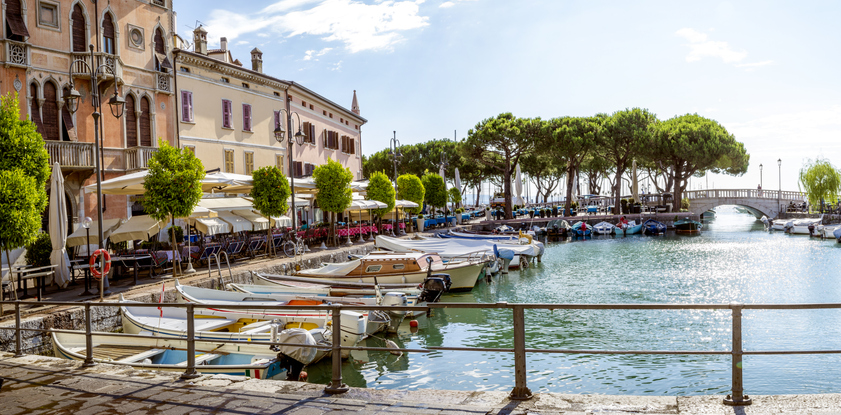Italy’s northern Lake District has a captivating beauty that makes it a wonderful year-round destination. Formed during the last ice age, Italy’s lakes offer a stunning combination of mountain scenery and colorful lakefronts, which have drawn visitors from all over Europe for centuries. From the largest lake, Lake Garda, to the chicest, Lake Como, and Lake Maggiore, which shares its shores with Switzerland, there is something for everyone.
Lake Garda
Known for its crystal-clear waters, Lake Garda is the largest lake in Italy. It sits about half way between Brescia and Verona, on the fringes of the Dolomite Mountains. At its longest, Lake Garda measures over 32 miles and the length of its shoreline falls just short of 100 miles—it goes without saying that there is plenty to see! Many of Lake Garda’s main attractions are located towards its lower bowl-shaped section, such as the picturesque village of Sirmione, with its fairytale 12th-century castle, the lively town of Desenzano, with lakeside bars and restaurants, and even the area’s very own theme park, Gardaland!
The narrow, northern part of Lake Garda is also popular with visitors, but has a steeper geography and is often windswept, making it a prime spot for windsurfers. A network of ferry routes crisscrosses the lake, giving you the opportunity to explore its varied shores or simply get out onto the water to soak up its beauty from a different perspective.
Lake Como
Lake Como is the third largest lake in Italy, but possibly its best known thanks to its celebrity links and exclusive atmosphere. The fifth deepest lake in Europe, Lake Como is shaped like an inverted letter Y. Narrow in places, its steep sides create a beauty that is breathtaking, which explains why so many luxury villas dot its shores and have done so since Roman times—George Clooney is merely the latest in a long line of VIP residents! The lake’s largest city is Como, nestled at the southerly end of its left-hand branch.
Como is a smart and lively place to visit that boasts a 14th-century cathedral, elegant shopping streets, and gorgeous lakeside gardens. The pretty town of Bellagio is synonymous with old-style lake glamour and sits on a promontory jutting out into the lake—its cobbled streets provide the perfect backdrop for views of the lake. Lake Como is also served by an elaborate network of ferries, but if you want to glide across its waters in truly glamorous fashion, you can’t beat a classic wooden launch.
Lake Maggiore
Lake Maggiore is shared between Italy and Ticino, Switzerland’s Italian-speaking canton. Spindly and sinuous, it is the longest lake in Italy with the most varied scenery. On its southerly shores, its most famous town is the elegant resort of Stresa, which boasts a string of 19th-century buildings that hark back to its heyday and a literary pedigree, having been a favorite of Stendhal, Lord Byron, and Ernest Hemingway.
Maggiore has a microclimate that makes it perfect for stunning botanical gardens, from the Borromean Islands, served by ferry from Stresa in the south, to the Brissago Islands further north. Maggiore has no shortage of pretty lakeside towns, such as the quintessentially Italian Luino with its cobbled lanes and Cannero, well known for its lemon groves. Don’t miss the evocative Santa Caterina del Sasso monastery, built right on the lake, or a trip up in the “bucket” lifts in Laveno to admire the views.
Lakes in Umbria and Lazio
Although the lakes of Italy’s northern Lake District region are the best known, there are plenty of lakes further south that are worth a visit for their gentler scenery and relaxed feel. On the border between Tuscany and Umbria, Lake Trasimeno is the fourth largest lake in Italy. Its most popular spots are Castiglione del Lago and Passignano, where you can enjoy a pizza on the lakefront.
Further south, in the Lazio region, lakes Bracciano and Bolsena were formed over 300,000 years ago and tend to be more off the beaten track for foreign visitors. Don’t miss the opportunity to explore the nearby castles or sample the delicious eel and fish caught in the lake.

